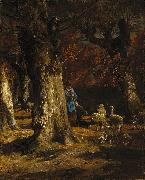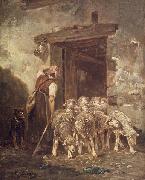Charles Jacque Huiler la Reproduction de TableauAll Charles Jacque Oil Paintings(23 May 1813 - 7 May 1894) was a French painter of animals (animalier) and engraver who was, with Jean-François Millet, part of the Barbizon School. He first learned to engrave maps when he spent seven years in the French Army. Fleeing the Cholera epidemics that besieged Paris in the mid-nineteenth century, Charles Jacque relocated to Barbizon in 1849 with Millet. There, he painted rustic or pastoral subject matter: shepherds, flocks of sheep, pigs, and scenes of farm life. In addition to painting, Jacque was also famous for his etchings and engravings. He, along with Felix Bracquemond and Felix Buhot, is credited with the nineteenth-century revival of seventeenth-century techniques. He began his career as an engraver around 1841 by publishing a series of etchings with Louis Marvy. He followed this work with a serious of engravings based on the works of Adriaen van Ostade, after which he began to create original engravings / artworks. Charles Baudelaire said of him, "Mr. Jacque new reputation will continue to grow always, we hope. His etchings are very bold and his subject matter is well conceived. All that Mr. Jacque does on copper is filled with a freedom and a frankness which reminds one of the Old Masters. |
|||

|
|||
|
|
|||
|
||||||||||||
| Charles Jacque (23 May 1813 - 7 May 1894) was a French painter of animals (animalier) and engraver who was, with Jean-François Millet, part of the Barbizon School. He first learned to engrave maps when he spent seven years in the French Army. Fleeing the Cholera epidemics that besieged Paris in the mid-nineteenth century, Charles Jacque relocated to Barbizon in 1849 with Millet. There, he painted rustic or pastoral subject matter: shepherds, flocks of sheep, pigs, and scenes of farm life. In addition to painting, Jacque was also famous for his etchings and engravings. He, along with Felix Bracquemond and Felix Buhot, is credited with the nineteenth-century revival of seventeenth-century techniques. He began his career as an engraver around 1841 by publishing a series of etchings with Louis Marvy. He followed this work with a serious of engravings based on the works of Adriaen van Ostade, after which he began to create original engravings / artworks. Charles Baudelaire said of him, "Mr. Jacque new reputation will continue to grow always, we hope. His etchings are very bold and his subject matter is well conceived. All that Mr. Jacque does on copper is filled with a freedom and a frankness which reminds one of the Old Masters. |
||||||||||||
|
|
||||||||||||
| ID de tableau:: 72165 The Old Forest The Old Forest between 1860(1860) and 1870(1870) Oil on canvas 82.6 X 66.7 cm (32.52 X 26.26 in) between 1860(1860) and 1870(1870) Oil on canvas 82.6 X 66.7 cm (32.52 X 26.26 in) |
||||||||||||
|
|
||||||||||||
| ID de tableau:: 73837 Leaving the Sheep Pen Leaving the Sheep Pen Date between 1880(1880) and 1889(1889) Medium Oil on panel Dimensions 45.7 X 37 cm (17.99 X 14.57 in) cyf Date between 1880(1880) and 1889(1889) Medium Oil on panel Dimensions 45.7 X 37 cm (17.99 X 14.57 in) cyf |
||||||||||||
|
|
||||||||||||
|
| Artiste précédent Artiste prochain | |||||||||||
|
|
||||||||||||
|
Charles Jacque (23 May 1813 - 7 May 1894) was a French painter of animals (animalier) and engraver who was, with Jean-François Millet, part of the Barbizon School. He first learned to engrave maps when he spent seven years in the French Army. Fleeing the Cholera epidemics that besieged Paris in the mid-nineteenth century, Charles Jacque relocated to Barbizon in 1849 with Millet. There, he painted rustic or pastoral subject matter: shepherds, flocks of sheep, pigs, and scenes of farm life. In addition to painting, Jacque was also famous for his etchings and engravings. He, along with Felix Bracquemond and Felix Buhot, is credited with the nineteenth-century revival of seventeenth-century techniques. He began his career as an engraver around 1841 by publishing a series of etchings with Louis Marvy. He followed this work with a serious of engravings based on the works of Adriaen van Ostade, after which he began to create original engravings / artworks. Charles Baudelaire said of him, "Mr. Jacque new reputation will continue to grow always, we hope. His etchings are very bold and his subject matter is well conceived. All that Mr. Jacque does on copper is filled with a freedom and a frankness which reminds one of the Old Masters. |
||||||||||||
|
|
||||||||||||
|
CONTACTER DES Etats-Unis |







